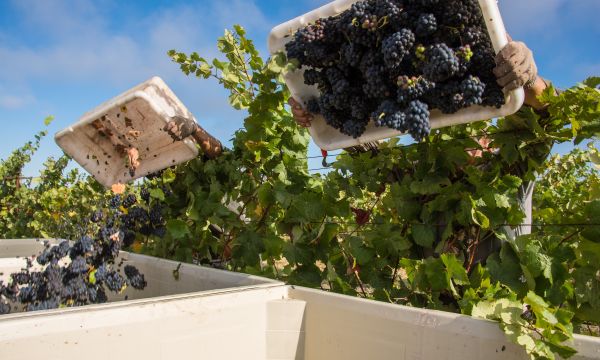As with anything agriculture, the timeline below is a general reference as to when certain grape varieties are picked in the Napa Valley. There are many factors that determine when the grapes are harvested: the grape variety itself; where in the Napa Valley the vineyard is situated; the influence of microclimates throughout the valley (fog, San Pablo Bay influence, hillside vs. valley floor, aspect and exposure, etc.); winemaking styles; soil types (looser, gravelly soils tend to ripen grapes early; heavier, clay soil, later); and in the end, how Mother Nature plays her cards. Harvest can stretch from late July and into November. There are overlaps and sometimes block by block picking, but below will give you a general sense of what comes in when and why.

Sparkling Wine
Grapes for sparkling wine are usually the first to be picked, heralding the start of “crush” and the frenetic days of harvest to come. The reason? To ensure the bright acidity that winemakers are looking for in sparkling wines. The primary grape varieties harvested for Napa Valley sparkling wines are Chardonnay and Pinot Noir, the majority of which are from the cooler Carneros region.

Sauvignon Blanc and other Aromatic White Wines
Sauvignon Blanc and other “aromatic” white wine grapes, like Riesling, Pinot Grigio or Chenin Blanc, are typically the next category of Napa Valley fine wine grapes to be brought from vineyard to crush pad. These grapes tend to mature earlier than most other grapes, as the citrus, tropical and other fruit flavor profiles that exude the enticing and sometimes bracingly refreshing scents are articulated at a particular acid/sugar ratio that requires less heat and time on the vine.

Chardonnay
Harvest is a moment to moment day to day affair; crews may be picking Sauvignon Blanc in particular regions of Napa Valley, while others are starting to bring in Chardonnay grapes that fit the individual style that specific winemaking is waiting patiently for. Napa Valley produces a wide range of Chardonnays, from lighter, delicate apple flavors that may or may not be influenced by oak or a touch of malolactic fermentation to deeper, richer flavors of pear or caramel with textures that typically take time in wood barrels and express a note or two of butter. Winemakers creating lighter styles are looking for slivers of bright acids showing through; those making Chardonnay with a sense of nectar are looking for slightly more developed sugars, translating to more time in the sun.

Pinot Noir
Our transition from the harvest of white wine grapes to red usually shifts with this delicate grape variety. As with all varietally classified wines, there are many expressions of a particular fine wine grape; Pinot grapes picked earlier have a fresh, plummy appeal and red tones; those picked later have a somewhat denser mouth feel and concentrated black fruit flavor. Key qualities for winemakers deciding upon a Pinot’s readiness for the press? Sweetness without astringency or tartness, the perfect pendulum of sugars and acids as harvest swings from late summer into fall.

Earlier Reds
Red wine grape varieties such as Merlot, Zinfandel, Cabernet Franc, Syrah and Sangiovese are often picked in advance of the most intense period of harvesting Cabernet Sauvignon grapes. Some of the reasons for this? These red wine grape varieties tend to flower earlier than Cabernet Sauvignon; they typically have thinner skins; and are usually less dependent on phenolic development (tannins) than many Cabernet Sauvignon grapes.

Cabernet Sauvignon
There are a multitude of variables that go into when Cabernet Sauvignon grapes are picked: the location of the vineyards within the Napa Valley’s 16 nested AVAs and the many microclimates in our region; hillside or valley floor fruit; whether the vines are on the eastern slope (which receives more hours of sunshine) vs. the western slope (which receives somewhat less sunshine); what type of soil the grapes are grown in (Napa Valley contains 33 soil series with more than 100 soil variations and half of the soil orders that can be found in the world); and the style of wine that the winemaker ultimately seeks to create. What we can say for sure is that the harvesting of Cabernet Sauvignon grapes in the Napa Valley begins later than most other varieties and typically lasts the longest. In some years that may mean the middle of November before Napa Valley’s harvest of grapes to make dry wines is officially considered “done!”

Late Harvest Wines
Late-harvest wines are made from grapes left on the vine longer than usual, allowing them to get riper and riper. In some cases, botrytis cinera, or noble rot, may be introduced onto the grapes. This makes the grapes naturally dehydrate, concentrating their flavors as they take on sweet, dense and complex flavors. These are some of the riskiest wines to make, as weather conditions during the late harvest season can, if severe enough, leave little fruit suitable for making fine wine. But when it works, these are some of the most luxurious and complex of all wines.

